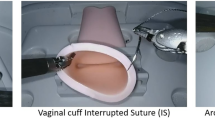Abstract
Purpose
To assess the efficacy of an accelerated proficiency-based training protocol in robotic simulation practice in delivering durable proficiency compared to conventional training methods.
Methods
Novice medical students (n = 16) were randomized into either the accelerated skills acquisition protocol (ASAP) or conventional training protocol (CTP). Subjects were trained to proficiency on the da Vinci Skills Simulator (dVSS) by an expert trainer. Differences in the repetitions required to achieve proficiency in two simple and two complex virtual reality (VR) training tasks were assessed as the primary outcome measure. Transfer of the acquired skills to two other non-practiced tasks was assessed immediately and prospectively followed through to 3, 6 and 12 months in the two groups. Retention of the practiced tasks was assessed along the same timeframe.
Results
Subjects in the ASAP group acquired proficiency significantly faster in three of the four training tasks: camera control (p = 0.0002), suture sponge (p < 0.0001), ring walk3 (p < 0.0001), and peg board (p = 0.6936). When assessing transfer of skills, there were no significant differences between the two groups: Ring rail 3 (p = 0.6807) and Tubes (p = 0.2240). When assessing retention of skills at 3, 6 and 12 months, for all 6 tasks, no significant differences were seen between the ASAP and CTP groups.
Conclusion
ASAP is proven to be an efficient approach for delivering proficiency in robotic VR simulation training. The results are durable when compared to conventional simulation training methods. The findings may have significant implications in the design of robotic VR simulation curricula.




Similar content being viewed by others
References
Torkington J et al (2001) The role of the basic surgical skills course in the acquisition and retention of laparoscopic skill. Surg Endosc 15(10):1071–1075
Reznick RK, MacRae H (2006) Teaching surgical skills–changes in the wind. N Engl J Med 355(25):2664–2669
Dawe SR et al (2014) Systematic review of skills transfer after surgical simulation-based training. Br J Surg 101(9):1063–1076
Stefanidis D et al (2008) Challenges during the implementation of a laparoscopic skills curriculum in a busy general surgery residency program. J Surg Educ 65(1):4–7
Chang L et al (2007) Integrating simulation into a surgical residency program: is voluntary participation effective? Surg Endosc 21(3):418–421
Stefanidis D, Acker CE, Greene FL (2010) Performance goals on simulators boost resident motivation and skills laboratory attendance. J Surg Educ 67(2):66–70
van Dongen KW et al (2008) Virtual reality training for endoscopic surgery: voluntary or obligatory? Surg Endosc 22(3):664–667
Schneider JR et al (2007) Implementation and evaluation of a new surgical residency model. J Am Coll Surg 205(3):393–404
Moglia A et al (2016) A systematic review of virtual reality simulators for robot-assisted surgery. Eur Urol 69(6):1065–1080
Intuitive Surgical (2018) Investor relations. https://isrg.intuitive.com/static-files/8bbddc9e-579c-47a1-ac91-fabe26e5e278. Accessed 9 Oct 2018
Liu M, Curet M (2015) A review of training research and virtual reality simulators for the da Vinci surgical system. Teach Learn Med 27(1):12–26
Lyons C et al (2013) Which skills really matter? proving face, content, and construct validity for a commercial robotic simulator. Surg Endosc 27(6):2020–2030
Stefanidis D, Acker C, Heniford BT (2008) Proficiency-based laparoscopic simulator training leads to improved operating room skill that is resistant to decay. Surg Innov 15(1):69–73
Kelly DC et al (2012) Face, content, and construct validation of the da Vinci skills simulator. Urology 79(5):1068–1072
Ericsson KA, Krampe RT, Tesch-Romer C (1993) The role of deliberate practice in the acquisition of expert performance. Psychol Rev 100(3):363–406
Seymour NE et al (2002) Virtual reality training improves operating room performance: results of a randomized, double-blinded study. Ann Surg 236(4):458–663 (discussion 463–4)
Foell K et al (2013) Robotic surgery basic skills training: Evaluation of a pilot multidisciplinary simulation-based curriculum. Can Urol Assoc J 7(11–12):430–434
Brewin J, Ahmed K, Challacombe B (2014) An update and review of simulation in urological training. Int J Surg 12(2):103–108
Smith R, Patel V, Satava R (2014) Fundamentals of robotic surgery: a course of basic robotic surgery skills based upon a 14-society consensus template of outcomes measures and curriculum development. Int J Med Robot 10(3):379–384
Ahmed K et al (2015) Development of a standardised training curriculum for robotic surgery: a consensus statement from an international multidisciplinary group of experts. BJU Int 116(1):93–101
Magill RA (2010) Motor learning and control: concepts and applications, vol 9. McGraw-Hill Humanities, New York
Martin V, Scholz JP, Schoner G (2009) Redundancy, self-motion, and motor control. Neural Comput 21(5):1371–1414
Sweller J (1988) Cognitive load during problem solving: effects on learning. Cogn Sci 12:257–285
van Merrienboer JJ, Sweller J (2010) Cognitive load theory in health professional education: design principles and strategies. Med Educ 44(1):85–93
Fraser KL, Ayres P, Sweller J (2015) Cognitive load theory for the design of medical simulations. Simul Healthc 10(5):295–307
Dias RD et al (2018) Systematic review of measurement tools to assess surgeons' intraoperative cognitive workload. Br J Surg 105(5):491–501
Stefanidis D et al (2006) Proficiency maintenance: impact of ongoing simulator training on laparoscopic skill retention. J Am Coll Surg 202(4):599–603
Park SW, Dijkstra TM, Sternad D (2013) Learning to never forget-time scales and specificity of long-term memory of a motor skill. Front Comput Neurosci 7:111
Lohse KR et al (2014) Motor skill acquisition across short and long time scales: a meta-analysis of neuroimaging data. Neuropsychologia 59:130–141
Author information
Authors and Affiliations
Contributions
PMSG: manuscript writing, data analysis. TC: data collection, manuscript revision. BW: statistical analysis. JVJ: manuscript revision, supervision. AEG: project conceptualization and management, manuscript revision, supervision.
Corresponding author
Ethics declarations
Conflicts of interest
The authors have no potential conflicts of interest to disclose.
Human and animal rights
The study was conducted with IRB approval.
Informed consent
Informed consent was obtained from all the participants prior to the study.
Additional information
Publisher's Note
Springer Nature remains neutral with regard to jurisdictional claims in published maps and institutional affiliations.
Rights and permissions
About this article
Cite this article
Gurung, P.M.S., Campbell, T., Wang, B. et al. Accelerated Skills Acquisition Protocol (ASAP) in optimizing robotic surgical simulation training: a prospective randomized study. World J Urol 38, 1623–1630 (2020). https://doi.org/10.1007/s00345-019-02858-9
Received:
Accepted:
Published:
Issue Date:
DOI: https://doi.org/10.1007/s00345-019-02858-9




